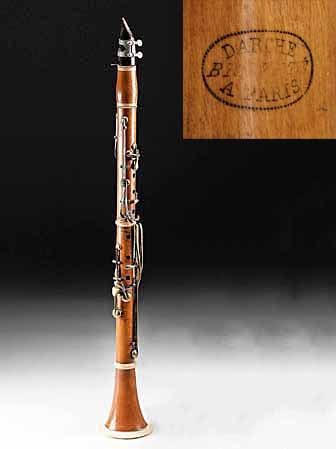
Owner: HWMC
Catalog#: 2CL-AERV-51
Clarinets
Darche '13-Keyed' Clarinet in Bb
Paris, France
Jean Nicolas Darche
Boxwood, ivory, metal
ca. 1830-1855
Length: 26 in; Width: 3.5 in
Wind Instruments – Woodwind Instruments – Single Reed
Engraved on the bell: DARCHE / BREVETE / A PARIS
This boxwood and ivory Jean Nicolas Darche 13-keyed clarinet in B-Flat, features the clarinetist Iwan Müller’s system (1812), which according to acclaimed author of ‘The Baroque Clarinet,’ Albert R. Rice is what brought the clarinet into the Romantic age. The basic idea was to allot a key or hole to every semitone and to place the tone-hole in the correct acoustical position. The main invention of Iwan Müller was a hinge key for the F3/C5 tone-hole, which was normally covered by the little finger. The advantage of the key-covered hole is that it can be bored at the optimal acoustic position and needn’t be undercut like the finger-hole before. This changes not only the whole disposition of the tone-holes but also the sound and the loudness of the clarinet.
Another major achievement of Müller was the saltspoon keyhead, which unfailingly closes the hole. This has a half ball shape that is filled with wool and covered with fish skin. The tone-hole has a profiled seating to fit the key. This Darche Brevete A Paris clarinet also shows the “needle spring” mounted on posts screwed into the clarinet, a new design of the throat A and Ab key, introduced by Auguste Buffet in 1837. It has four boxwood sections with ivory ferrules (fine turnings) and bell mount.
Jean Nicolas DARCHE (1806-1885) of Mirecourt, France, arrived in Paris around 1825 and worked with Claude Hippolyte Collin (1766-1831). a luthier and musical instrument dealer there in Paris. Following Collin’s death, Darche bought the business from Collin’s widow and continued to supply all types of instruments including flutes, clarinets, and flageolets. In 1840 he produced, in collaboration with the trumpeter Schlitz, the natural straight trumpets. Then in 1841 he proposed the invention: keyboard flageolets called ‘flageolet a clavier,’ and in 1843 obtained a five-year patent for a combination bass drum and snare drum that could be used as a harmony timpani. In 1844 he presented church organs, timpani, and bass drums at the Paris exhibition. Then in 1846, he obtained a new patent for a ‘transposing piston keyboard applicable to all keyboard instruments. Finally in 1848 he obtained a patent for a so called ‘signal trumpet’ instrument suitable as a ship siren. In other words, a type of ‘foghorn.’ Then at the 1849 Paris exhibition in Paris he received a medal of honor for trumpets and chromatic trumpets.’ By 1855 he passed the business on to his nephew Eugene Leopold Henry (1819-1872), who associated with Jules David Martin (1826-1872) as Henri & Martin. They were the first to make an agreement with Adophe Sax to manufacture saxhorns and saxotrombas under the Sax License.
Resources: Clarinets in the Edinburgh University Collection of Historic Musical Instruments. http://www.music.ed.ac.uk/euchmi/ugw/ugwf1i.html; http://facteursetmarchand sdemusique.blogspot.fr/2014/12/la-famile-darche-luthers-de-mirecourt.html; https://1-rp–archivesmusiquefacteurs-blogspot-com.translate.goog/2016/11/la-famille-darche-luthiers-de-mirecourt_25.html?_x_tr_enc=1&_x_tr_sl=fr&_x_tr_tl=en&_x_tr_hl=en&_x_tr_pto=nui,sc; ‘The New Lanagwill Index: A Dictionary O Musical Wind Instrument Makers and Inventors,’ 1993, William Waterhouse. Pub. Tony Bingham., pp 80-81
